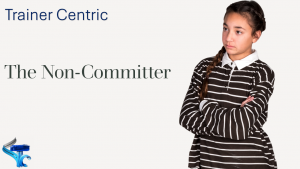In the dynamic realm of training, understanding and effectively managing different types of difficult trainees is a crucial skill for trainers seeking to create engaging and productive learning environments. These challenging participants come in various personas, each with unique characteristics that can influence the dynamics of a classroom.
In this comprehensive guide, we will unravel 30 distinct types of difficult trainees, providing insights into their behavior, strategies for identification, and practical approaches for trainers to navigate these challenges successfully.

Understanding Types of Difficult Trainees
Definition: Difficult trainees are participants who, intentionally or not, disrupt the smooth flow and effectiveness of a training session. Their behavior can range from active disruption to passive resistance, impacting the overall learning experience for themselves and their peers.
Now, let’s explore the 30 types of difficult trainees, their characteristics, and how they may behave in a classroom setting.
1. The Dominator
Behavior in the Classroom: This is one of types of difficult trainees who eagerly shares opinions, often dominating discussions and overshadowing others’ contributions. Their assertiveness can hinder the free flow of ideas among participants, creating an imbalanced learning environment.

- Characteristics: The Dominator tends to assert control over discussions, often monopolizing the conversation. They may interrupt others, overshadowing diverse perspectives and hindering collaborative learning.
- Identification: The Dominator can be identified by their frequent interruptions, dominating speaking time, and steering discussions toward their viewpoints. They may display impatience when others speak.
- Handling Strategy: Manage the Dominator by setting clear guidelines for equitable participation. Encourage them to listen actively and provide space for others to contribute. Use strategies like round-robin discussions to ensure balanced engagement.
2. The Resistor
Behavior in the Classroom: This is one of types of difficult trainees who expresses skepticism openly or through body language, challenging the trainer’s authority and the perceived value of the training. Their resistance may manifest in disruptive questioning or a passive-aggressive demeanor, impacting the overall class morale.

- Characteristics: The Resistor opposes new concepts or methodologies, expressing reluctance to embrace change. They may resist actively participating in training activities.
- Identification: The Resistor may vocalize skepticism, express discomfort with new ideas, and show hesitancy in adopting suggested practices. They might disengage or exhibit passive resistance.
- Handling Strategy: Address the Resistor by acknowledging their concerns and providing tangible examples of the benefits of the proposed changes. Foster a supportive environment that encourages questions and gradually introduce changes to ease their resistance.
3. The Disruptor
Behavior in the Classroom: This is one of types of difficult trainees who actively disrupts the learning environment by engaging in distracting behavior. This can include side conversations, using electronic devices, or making unrelated comments, diverting the attention of the entire class and hindering the learning process.

- Characteristics: The Disruptor intentionally causes disruptions, diverting attention from the training content. They may engage in disruptive behaviors to challenge authority or seek attention.
- Identification: The Disruptor can be identified by their intentional disruptions, such as loud interjections, off-topic comments, or distracting actions. They may resist adhering to established norms.
- Handling Strategy: Manage the Disruptor by addressing their disruptions promptly and privately. Set clear expectations for behavior and consequences. Redirect their energy positively by involving them in relevant discussions and activities.
4. The Silent Observer
Behavior in the Classroom: This is one of types of difficult trainees who rarely participates verbally, choosing to remain silent throughout the session. This reserved behavior may hinder group dynamics, as their insights and perspectives are not contributing to the collective learning experience.

- Characteristics: The Silent Observer remains passive and refrains from active participation. They may avoid contributing to discussions or sharing insights.
- Identification: The Silent Observer can be identified by their minimal verbal contributions, limited engagement in group activities, and a preference for observing rather than participating.
- Handling Strategy: Engage the Silent Observer by creating a non-threatening environment. Encourage their contributions through small-group discussions, where they may feel more comfortable expressing their thoughts. Recognize and value their insights when they choose to share.
5. The Over-Engager
Behavior in the Classroom: While enthusiastic, this is one of types of difficult trainees who may become a challenge by derailing discussions due to excessive enthusiasm. They may dominate discussions with overzealous contributions, overshadowing other participants and affecting the overall balance of the class.

- Characteristics: The Over-Engager exhibits excessive enthusiasm, often dominating discussions. They may overpower others with their eagerness to participate.
- Identification: The Over-Engager can be identified by their frequent contributions, enthusiasm that may border on disruptive, and a tendency to dominate group activities.
- Handling Strategy: Manage the Over-Engager by channeling their enthusiasm positively. Encourage them to listen actively, allowing others to contribute. Set expectations for balanced participation and provide opportunities for reflection to avoid overwhelming the group.
6. The Multitasker
Behavior in the Classroom: This is one of types of difficult trainees who is constantly engaged in unrelated activities, such as checking emails or using devices. This lack of focus on the training materials can lead to a diminished learning experience for the individual and potentially disrupt others around them.

- Characteristics: The Multitasker engages in non-training activities during the session, such as using electronic devices or working on unrelated tasks.
- Identification: The Multitasker can be identified by their divided attention, continuous use of electronic devices, or visible engagement in activities unrelated to the training.
- Handling Strategy: Address the Multitasker by emphasizing the importance of focused attention during training. Establish clear guidelines on device usage and create interactive sessions to maintain engagement. Encourage active participation to minimize distractions.
7. The Know-It-All
Behavior in the Classroom: This is one of types of difficult trainees who are overconfident in their knowledge, consistently provides answers and may resist new information. This behavior can disrupt the learning flow, as they may challenge the trainer or dismiss the perspectives of their peers.

- Characteristics: The Know-It-All possesses an overconfident demeanor and believes they are already knowledgeable in the training content. They may resist additional learning.
- Identification: The Know-It-All can be identified by their dismissive attitude toward new information, constant interruptions to showcase their knowledge, and resistance to acknowledging the expertise of others.
- Handling Strategy: Manage the Know-It-All by acknowledging their knowledge while emphasizing the value of continuous learning. Encourage humility and create opportunities for them to share insights without dominating discussions.
8. The Tangent Taker
Behavior in the Classroom: This is one of types of difficult trainees who easily gets distracted, frequently steering discussions away from the main topic. This tendency to go off on tangents can lead to deviations from the planned curriculum, potentially causing confusion and disrupting the learning agenda.

- Characteristics: The Tangent Taker consistently veers off-topic, steering discussions away from the intended training content.
- Identification: The Tangent Taker can be identified by their tendency to introduce unrelated topics, often extending discussions beyond the scope of the training agenda.
- Handling Strategy: Address the Tangent Taker by gently guiding discussions back to the main topics. Set clear expectations for relevance and provide opportunities for off-topic discussions during designated times.
9. The Procrastinator
Behavior in the Classroom: This is one of types of difficult trainees who exhibits low engagement, often falling behind in completing assignments or participating actively. Their delayed responses and lack of involvement can impact group activities and slow down the overall learning pace.

- Characteristics: The Procrastinator delays tasks but excels when pressured. While they may meet deadlines, their last-minute approach can create stress.
- Identification: The Procrastinator can be identified by their tendency to postpone tasks until close to deadlines, often creating urgency for completion.
- Handling Strategy: Support the Procrastinator by incorporating structured timelines and regular check-ins. Emphasize the benefits of consistent engagement throughout the training period.
10. The Negative Naysayer
Behavior in the Classroom: This is one of types of difficult trainees who expresses pessimism, challenging new ideas and potentially impacting the enthusiasm of others. Their negative outlook can create a less constructive learning environment, affecting the motivation and engagement of fellow participants.

- Characteristics: The Negative Naysayer consistently expresses pessimism, casting doubt on proposed ideas and solutions.
- Identification: The Negative Naysayer can be identified by their tendency to focus on potential problems, resist change, and express skepticism toward positive initiatives.
- Handling Strategy: Address the Negative Naysayer by acknowledging concerns and providing evidence of positive outcomes. Foster a constructive environment where alternative viewpoints are considered, but negativity is redirected toward finding solutions.
11. The Side Conversationalist
Behavior in the Classroom: This is one of types of difficult trainees who engages inside conversations that disrupt the session, impacting the focus of the entire class. Their conversations may distract others and create a fragmented learning environment.

- Characteristics: The Side Conversationalist engages in separate conversations during training, distracting others and disrupting the learning environment.
- Identification: The Side Conversationalist can be identified by their continuous engagement in private discussions, often leading to disruptions in the overall learning flow.
- Handling Strategy: Address the Side Conversationalist by emphasizing the importance of focused attention during training. Encourage open discussions within the group and set expectations for minimal side conversations to maintain a conducive learning environment.
12. The Non-Committer
Behavior in the Classroom: This is one of types of difficult trainees who exhibits low engagement and minimal commitment, rarely participating actively or showing enthusiasm. This lack of involvement can create a sense of apathy in the class, affecting the overall energy and motivation levels.

- Characteristics: The Non-Committer displays indifference and avoids committing to active participation in training activities.
- Identification: The Non-Committer can be identified by their passive demeanor, limited engagement, and reluctance to actively contribute to discussions or group activities.
- Handling Strategy: Engage the Non-Committer by creating an inclusive and supportive atmosphere. Encourage their participation through low-pressure activities, gradually building their comfort with sharing insights.
13. The “Been There, Done That” Expert
Behavior in the Classroom: Disengaged from new information, This is one of types of difficult trainees who may resist learning, feeling they already possess extensive knowledge. Their reluctance to engage with new content can hinder discussions and limit the diversity of perspectives in the class.

- Characteristics: The “Been There, Done That” Expert believes they have extensive knowledge and may dismiss training content as redundant.
- Identification: The “Been There, Done That” Expert can be identified by their dismissive attitude toward new information, constant references to past experiences, and resistance to acknowledging the relevance of the training.
- Handling Strategy: Manage the “Been There, Done That” Expert by acknowledging their expertise while emphasizing the value of continuous learning. Connect training content to real-world applications, demonstrating its relevance to both novice and experienced participants.
14. The Emotional Reactor
Behavior in the Classroom: This is one of types of difficult trainees who easily becomes emotional, reacting strongly to feedback or discussions. This emotional volatility can influence the overall tone of the class, creating a potentially uncomfortable atmosphere for other participants.

- Characteristics: The Emotional Reactor reacts strongly to training content, expressing intense emotions that may impact the overall learning atmosphere.
- Identification: The Emotional Reactor can be identified by their heightened emotional responses, which may include frustration, excitement, or distress during various training activities.
- Handling Strategy: Address the Emotional Reactor by providing a supportive environment for expressing emotions. Encourage constructive responses and guide them toward channeling emotions positively.
15. The Time Optimist
Behavior in the Classroom: This is one of types of difficult trainees who consistently arrives late, disrupting the schedule and potentially impacting the learning flow. Their tardiness can lead to interruptions and a fragmented learning experience for both the individual and the group.

- Characteristics: The Time Optimist underestimates the time required for tasks, potentially causing delays and disruptions in the training schedule.
- Identification: The Time Optimist can be identified by their tendency to allocate insufficient time for tasks, leading to rushed or incomplete activities.
- Handling Strategy: Support the Time Optimist by incorporating realistic timelines and emphasizing the importance of pacing activities appropriately. Provide guidance on time management and encourage foresight in planning to enhance the overall learning experience.
16. The Technology Resister
Behavior in the Classroom: Resistant to using technology during training, This is one of types of difficult trainees who may hinder the adoption of digital tools. Their reluctance can limit the exploration of innovative learning methods and disrupt the integration of technology into the training process.

- Characteristics: The Technology Resister opposes the use of technological tools during training, expressing discomfort or resistance to incorporating digital elements.
- Identification: The Technology Resister can be identified by their reluctance to engage with digital tools, vocalizing concerns about technology’s role in the training environment.
- Handling Strategy: Address the Technology Resister by providing clear explanations of the benefits of technology in training. Offer guidance and support to ease their discomfort with digital tools, gradually integrating technology to enhance the overall learning experience.
17. The Insecure Contributor
Behavior in the Classroom: This is one of types of difficult trainees who is fearful of judgment and hesitates to share thoughts. Their self-doubt may lead to minimal participation, hindering the diversity of ideas in group discussions and limiting the overall richness of the learning Experience.

- Characteristics: The Insecure Contributor hesitates to share ideas or opinions, fearing judgment or criticism from peers.
- Identification: The Insecure Contributor can be identified by their minimal verbal contributions, hesitancy to express opinions, and a reluctance to share ideas during group discussions.
- Handling Strategy: Engage the Insecure Contributor by fostering a supportive and non-judgmental environment. Encourage their participation through small-group discussions, gradually building their confidence to contribute openly. Recognize and appreciate their insights to boost their self-esteem.
18. The Taskmaster
Behavior in the Classroom: This is one of types of difficult trainees who attempts to control the pace and direction of the training. While enthusiastic, their desire for control may lead to disruptions, as they may resist following the planned agenda and steer discussions in their preferred direction.

- Characteristics: The Taskmaster excessively focuses on completing assigned tasks, potentially overlooking collaborative aspects and interpersonal dynamics.
- Identification: The Taskmaster can be identified by their intense focus on task completion, often neglecting the importance of group interactions and interpersonal relationships.
- Handling Strategy: Address the Taskmaster by emphasizing the value of collaborative learning and interpersonal skills. Integrate activities that highlight the significance of teamwork and communication to create a more holistic training experience.
19. The Jargon Enthusiast
Behavior in the Classroom: This is one of types of difficult trainees who overuses industry-specific jargon, potentially alienating others. This reliance on complex terminology can hinder effective communication, creating a barrier for participants who may not be familiar with the specialized language.

- Characteristics: The Jargon Enthusiast excessively uses industry-specific jargon, potentially alienating participants unfamiliar with the terminology.
- Identification: The Jargon Enthusiast can be identified by their frequent use of specialized language, making discussions challenging for participants who may not be well-versed in the industry’s jargon.
- Handling Strategy: Manage the Jargon Enthusiast by encouraging clear communication and explaining complex terms when used. Foster an inclusive environment where participants can seek clarification on terminology, promoting effective knowledge transfer.
20. The Excuse-Maker
Behavior in the Classroom: This is one of types of difficult trainees who frequently offers excuses for non-participation, providing reasons for incomplete tasks. This behavior can disrupt the learning flow, as it may divert attention from the training content and focus on individual justifications.

- Characteristics: The Excuse-Maker habitually provides reasons for not completing tasks or participating fully, potentially hindering the learning process.
- Identification: The Excuse-Maker can be identified by their consistent justifications for incomplete tasks, reluctance to take responsibility, and a tendency to shift blame.
- Handling Strategy: Address the Excuse-Maker by setting clear expectations for accountability and responsibility. Encourage a proactive mindset and guide them toward problem-solving rather than making excuses. Foster a culture of ownership and commitment within the training environment.
21. The Social Butterfly
Behavior in the Classroom: This is one of types of difficult trainees who is more focused on socializing than participating in training activities. Their desire for social interaction can lead to disruptions, as they may prioritize conversations over learning tasks, impacting the overall class engagement.

- Characteristics: The Social Butterfly prioritizes social interactions over training activities, potentially leading to distractions and disruptions.
- Identification: The Social Butterfly can be identified by their continuous engagement in conversations with peers, often diverting attention away from the training content.
- Handling Strategy: Manage the Social Butterfly by creating designated social breaks and opportunities for peer interactions. Emphasize the importance of focused attention during training sessions and set expectations for balancing social interactions with learning activities.
22. The Quiet Rebel
Behavior in the Classroom: This is one of types of difficult trainees who subtly resists authority and established norms. Their resistance may manifest through non-verbal cues, challenging the trainer’s directives without overtly expressing dissent.

- Characteristics: The Quiet Rebel subtly resists authority or established norms without overtly expressing dissent.
- Identification: The Quiet Rebel can be identified by their subtle resistance to following established guidelines, often challenging norms without overtly expressing disagreement.
- Handling Strategy: Engage the Quiet Rebel by encouraging open communication and seeking their perspectives on established norms. Foster a collaborative environment where they feel comfortable expressing their opinions constructively. Address concerns calmly and guide them toward constructive dialogue.
23. The Questioning Challenger
Behavior in the Classroom: This is one of types of difficult trainees who consistently questions the trainer’s authority and challenges information presented. While critical thinking is encouraged, their persistent questioning may disrupt the learning flow and create a confrontational atmosphere.

- Characteristics: The Questioning Challenger consistently challenges concepts and ideas through insightful questions, fostering critical thinking.
- Identification: The Questioning Challenger can be identified by their habit of posing thought-provoking questions that encourage deeper exploration of concepts and ideas.
- Handling Strategy: Support the Questioning Challenger by acknowledging the value of critical thinking. Encourage their contributions and guide discussions to explore the nuances of the training content. Foster an environment where questioning is viewed as a positive aspect of the learning process.
24. The Status Seeker
Behavior in the Classroom: This is one of types of difficult trainees who seeks recognition and validation from the trainer. This desire for acknowledgment can lead to disruptions, as they may divert discussions to showcase their knowledge or skills, potentially overshadowing others.

Characteristics: The Status Seeker seeks recognition and validation from the trainer and peers. They often showcase their knowledge or skills to gain acknowledgment and elevate their status in the training environment.
Identification: The Status Seeker may frequently interject with personal achievements or experiences, often steering discussions to highlight their expertise. They seek approval through non-verbal cues, such as expecting affirmations or nods from the trainer.
Handling Strategy: To effectively handle the Status Seeker, provide opportunities for acknowledgment within the training structure. Encourage positive contributions and acknowledge their insights when relevant. Additionally, redirect the focus back to the collective learning goals, ensuring that individual recognition doesn’t overshadow the overall training objectives.
25. The Uncommitted Bystander
Behavior in the Classroom: This is one of types of difficult trainees who remains indifferent to training activities, neither actively participating nor causing disruptions. Their passive resistance may create a challenge, as their lack of engagement can impact the overall energy of the class.

Characteristics: The Uncommitted Bystander remains indifferent to training activities, neither actively participating nor causing disruptions. They may display a lack of interest, engagement, or enthusiasm throughout the training session.
Identification: The Uncommitted Bystander often appears disengaged, avoiding active participation in discussions or group activities. Their body language may convey a sense of passivity, such as slouching, lack of eye contact, or minimal interaction with training materials.
Handling Strategy: To engage the Uncommitted Bystander, employ interactive activities that encourage participation without putting them on the spot. Seek their opinions through open-ended questions, fostering a sense of inclusivity. Address any potential barriers to engagement and emphasize the relevance of the training content to enhance their motivation.
26. The Selective Listener
Behavior in the Classroom: This is one of types of difficult trainees who tunes in and out of the training, focusing on specific elements while ignoring others. This behavior can lead to misunderstandings and gaps in knowledge, affecting their overall comprehension of the training material.

Characteristics: The Selective Listener tunes in and out of the training, focusing on specific elements while ignoring others. They may exhibit intermittent attention, leading to potential gaps in understanding the training material.
Identification: The Selective Listener may display signs of distraction, such as checking devices, looking around the room, or appearing disinterested during certain segments of the training. Their responses to questions may indicate a partial grasp of the content.
Handling Strategy: To support the Selective Listener, incorporate varied and engaging content to maintain their attention. Use active listening techniques and periodically check comprehension through targeted questions. Provide visual aids or interactive elements to cater to different learning preferences and reinforce key concepts.
27. The Serial Debater
Behavior in the Classroom: This is one of types of difficult trainees who enjoys engaging in prolonged debates. While healthy discussions are encouraged, their tendency to prolong debates excessively can disrupt the training schedule and impact the coverage of essential content.

Characteristics: The Serial Debater enjoys engaging in prolonged debates, often expressing opinions to a greater extent than necessary. While healthy discussions are encouraged, their tendency to prolong debates excessively can disrupt the training schedule.
Identification: The Serial Debater actively seeks opportunities to engage in debates, even on topics tangential to the training agenda. They may challenge viewpoints persistently and resist moving on from a discussion point.
Handling Strategy: Manage the Serial Debater by setting clear expectations for discussion duration and relevance to the training goals. Encourage concise contributions and redirect the focus when debates become overly extended. Ensure that debates contribute positively to the learning experience without dominating the entire training session.
28. The Sudden Challenger
Behavior in the Classroom: This is one of types of difficult trainees who unpredictably challenges content or the trainer. Their disruptions may arise without apparent cause, creating an element of unpredictability in the classroom that trainers need to address calmly and inquire about privately.

Characteristics: The Sudden Challenger unpredictably challenges content or the trainer. Their disruptions may arise without apparent cause, creating an element of unpredictability in the classroom.
Identification: The Sudden Challenger may interject abruptly with opposing viewpoints, catching both the trainer and participants off guard. Their challenges may not follow a pattern and can disrupt the natural flow of the training.
Handling Strategy: Address the Sudden Challenger calmly and inquire about their concerns privately. Seek to understand the motive behind their challenges and guide them back to the established learning objectives. By addressing their concerns individually, trainers can prevent unnecessary disruptions and foster a more focused training environment.
29. The Procrastinating Achiever
Behavior in the Classroom: This is one of types of difficult trainees who delays tasks but excels when pressured. While they may meet deadlines, their last-minute approach can create stress and potentially disrupt the collaborative aspects of the training.

Characteristics: The Procrastinating Achiever delays tasks but excels when pressured. While they may meet deadlines, their last-minute approach can create stress and potentially disrupt the collaborative aspects of the training.
Identification: The Procrastinating Achiever may exhibit a pattern of delaying tasks until close to deadlines, creating a sense of urgency for completion. Despite the procrastination, they often demonstrate competence when under pressure.
Handling Strategy: Support the Procrastinating Achiever by incorporating structured timelines and regular check-ins. Emphasize the importance of consistent engagement throughout the training period. Provide guidance on time management and help them recognize the benefits of early participation for a more enriching learning experience.
30. The Passive Dissenter
Behavior in the Classroom: This is one of types of difficult trainees who subtly resists training by disengaging emotionally. While not overtly disruptive, their lack of enthusiasm can impact the overall class energy and impede the creation of a vibrant learning atmosphere.

Characteristics: The Passive Dissenter subtly resists training by disengaging emotionally. While not overtly disruptive, their lack of enthusiasm can impact the overall class energy and impede the creation of a vibrant learning atmosphere.
Identification: The Passive Dissenter may display minimal emotional expression, participate minimally, and appear disinterested during training activities. Their body language may convey a sense of detachment.
Handling Strategy: Engage the Passive Dissenter by creating a supportive and inclusive atmosphere. Encourage participation through low-pressure activities, providing opportunities for them to express opinions gradually. Foster a positive learning environment that motivates passive dissenters to actively contribute and feel valued within the training community.
Top 5 Tips for Handling Difficult Trainees
Here are some top tips that trainers can keep in mind when dealing with difficult trainees:
Preparation is Key: Thoroughly preparing for each training session is the cornerstone of effective facilitation when it comes to handle different types of difficult trainees. Anticipating challenges allows you to proactively address potential issues, ensuring a smooth and productive learning experience.
This preparation extends beyond content mastery; it involves creating contingency plans, understanding potential participant dynamics, and being ready to adapt your approach in real-time. A well-prepared trainer exudes confidence, which positively influences participant engagement and contributes to the overall success of the training session with different types of difficult trainees.
Know Your Audience: Understanding the personalities and expectations of your participants before the training session is crucial for tailoring your approach specially while handling different types of difficult trainees. Conducting pre-session assessments or discussions with participants allows you to gain insights into their learning styles, preferences, and any potential challenges they may face.
This knowledge enables you to customize your delivery, making the content more relatable and ensuring that the training meets the diverse needs of the participants. By fostering this understanding, you create an inclusive and participant-centric learning environment.
Set Clear Expectations: Establishing clear ground rules and expectations from the outset lays the foundation for a positive and structured learning environment. Communicate the objectives of the training, the expected code of conduct, and any specific guidelines for participation from different types of difficult trainees.
Clarity on expectations helps manage participants’ behavior and fosters a sense of accountability. This transparency also allows participants to align their mindset with the training goals, promoting a cohesive and focused learning atmosphere.
Engage Participants Early: The initial moments of a training session are critical for setting the tone and engaging participants particular for the different types of difficult trainees. Incorporating icebreakers or interactive activities at the beginning captures attention, creates a positive atmosphere, and encourages active participation.
These engagement strategies not only energize participants but also establish a sense of camaraderie within the group. Early engagement is pivotal in creating momentum for the rest of the session, ensuring that participants remain attentive and invested in the learning process.
Individualize Approach: Recognizing and catering to different learning styles and personalities of each type of the difficult trainees enhances the effectiveness of your training. Individuals absorb information in various ways, and adapting your approach to accommodate these differences promotes inclusive learning.
Some types of difficult trainees may thrive in interactive discussions, while others may prefer individual reflection. By incorporating a variety of teaching methods and allowing flexibility in your delivery, you create an environment where each participant can grasp and retain information according to their unique preferences, ultimately maximizing the impact of the training.
Conclusion
Effectively managing different types of difficult trainees is an art that requires a nuanced understanding of individual behaviors and proactive strategies for engagement. By recognizing the diverse characteristics and behaviors exhibited by different types of difficult trainees, trainers can tailor their approaches, creating a more inclusive and dynamic learning environment for all participants.
Employing the right strategies and maintaining a flexible mindset will empower trainers to navigate the complexities of the training landscape successfully.

![The Power of Storytelling in Corporate Training: Igniting Success and Inspiring Growth [2023]](https://trainercentric.com/wp-content/uploads/2023/06/storytelling-1024x576.jpg)

